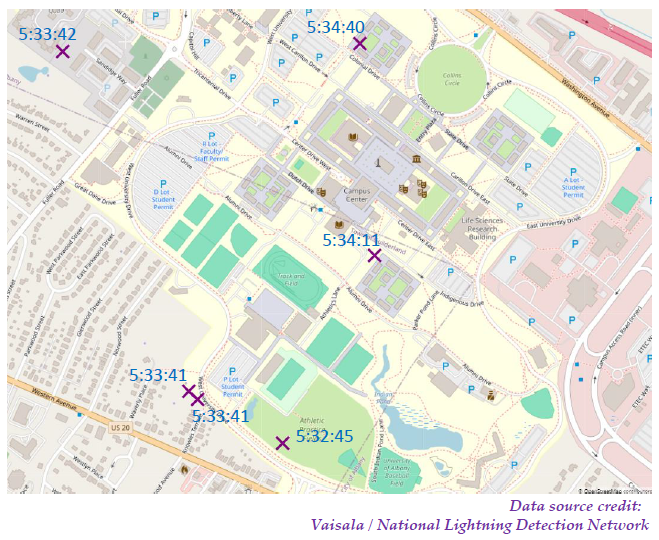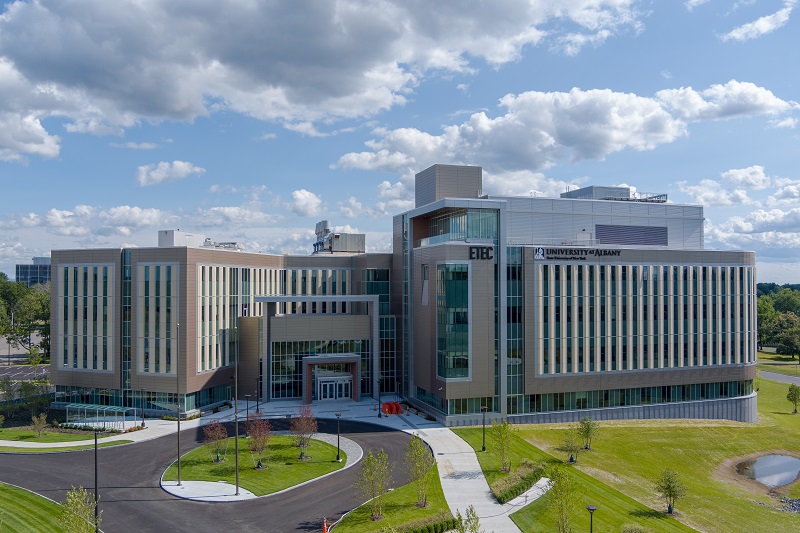In a flash, an iconic image of UAlbany

ALBANY, N.Y. (July 19, 2024) — The damaging summer storms that spawned at least five tornados across New York Tuesday also produced an exceptional lightshow above UAlbany’s Uptown Campus.
George Berg, an associate professor of cybersecurity, had a front-row seat.
Berg, who was recording the storm with his phone (video of it can be seen here), was among those gathered to watch the storm from the fifth-floor weather observation deck in ETEC when a ragged bolt of lightning appeared to strike the top of Mohawk Tower on Indigenous Quad, just to the west.
But did it?
Kevin Tyle, manager of departmental computing for the Department of Atmospheric and Environmental Sciences (DAES), which is based in ETEC, analyzed data from the National Lightning Detection Network (NLDN). That data shows not one but six cloud-to-ground lightning strikes on or near the Uptown Campus between 5:32 and 5:34 p.m. Tuesday, according to Tyle’s analysis.
One strike, at 5:34:11 p.m., appears to have hit just northwest of Mohawk Tower behind Oneida Hall, likely the one seen by Berg and the other weather watchers inside ETEC.
That was the same moment, to the minute, that the DAES weather observation camera mounted on top of Mohawk Tower and facing southwest toward the campus athletic complex stopped recording for about 10 minutes.
This time lapse video recorded by a DAES camera on the roof of Mohawk Tower shows Tuesday's storm advancing on campus from the west and cuts out for about 10 minutes at 5:34 p.m., the same time lightning is believed to have struck the tower.
Another cloud-to-ground strike hit near the corner of Hamilton and Delancey halls on Colonial Quad about 30 seconds later.
Now operated by Vaisala, the NLDN was originally developed and deployed by UAlbany DAES faculty and staff back in the 1980s, and the department maintains a continuous archive of NLDN data from 1990 to the present.
At about 205 feet tall, Mohawk Tower is the tallest residential building on UAlbany's campus — taller than the towers on the other three quads because Mohawk has an additional rooftop Sky Lounge initially designed by Edward Durell Stone as a meteorological research station, said Randall Olocki, director of planning, design and construction on campus. At 250 feet, the Podium carillon is the tallest structure on campus.
Ross Lazear, a DAES lecturer, noted there is some degree of uncertainty in the exact locations recorded in the NLDN data, meaning in both cases it could have been the towers (Mohawk on Indigenous, Livingston on Colonial) that were struck, even if the location data doesn't exactly match. Using the loss of power to the Mohawk Tower camera as an additional data point, Lazear said it’s likely the tower was struck. Knowing for sure would require a visual inspection of nearby trees and other clues.
In the immediate aftermath of the storm, Facilities Management reported no issues in either quad.
Lightning safety
Lazear said it’s not unusual for this type of electrical thunderstorm to produce so much cloud-to-ground lightning, which is why it’s important for people to practice lightning safety no matter where they are.
According to the National Weather Service, about 300 people are struck by lightning in the United States each year. NWS advises there is no safe place to be outside during a thunderstorm and you should get indoors or to a hard-topped vehicle as soon as you hear thunder because lightning can strike well beyond the immediate area where rain is falling.
If you are caught outside during a thunderstorm, NWS offers the following safety tips:
- Avoid open areas. Don’t be the tallest object in the area.
- Stay away from isolated tall trees, towers or utility poles. Lightning tends to strike the taller objects in an area.
- Stay away from metal conductors such as wires or fences. Metal does not attract lightning, but lightning can travel long distances through it.
- If you are with a group of people, spread out. While this actually increases the chance that someone might get struck, it tends to prevent multiple casualties, and increases the chances that someone could help if a person is struck.
Tuesday’s storm is an example of UAlbany’s built environment supporting its academic and research mission. In addition to DAES, ETEC is home to UAlbany’s Atmospheric Sciences Research Center, the New York State Mesonet, the State Weather Risk Communication Center and the Albany office of the National Weather Service.
The ETEC weather observation deck was intentionally designed to face west to provide the best vantage point for students and faculty to observe these kinds of storms, which typically approach campus from that direction. During severe storms, faculty and students can often be found there observing the phenomena they learn about in the classroom.
“We work very hard to ensure that the facilities we provide students and faculty are not just beautiful and comfortable but actively support the teaching and research that happens inside them,” said Vice President for Finance and Administration Todd Foreman. “The ETEC weather deck is a prime example of that, and it’s exciting to see it being used in exactly the way we imagined it would be.”






